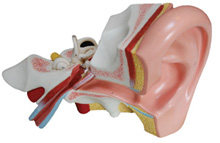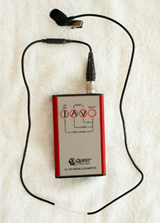Prevention
How We Hear

Courtesy of Stephanie Sjoblad
The ear is divided into three parts: the outer ear, the middle ear, and the inner ear. The outer ear consists of the pinna, the visible part of the inner ear; and the ear canal, which leads to the eardrum. The eardrum is the dividing line between the outer ear and the middle ear. Inside the middle ear are three tiny bones: the malleus, the incus, and the stapes. The smallest bones in the body, the three comprise what is called the ossicular chain.
The stapes, which is the bone closest to the inner ear, is attached to the oval window, the membrane at the opening of the inner ear. Vibrations from the ossicular chain are transmitted to the fluids of the inner ear by movements of the stapes in and out of the oval window.
The fluid-filled inner ear consists of the semi-circular canals, which are essential for balance, and the cochlea, which is the sensory organ for hearing. It is through the cochlea that nerve signals travel from the ear to the brain.
Along the length of the fluid-filled cochlea is a membrane lined with microscopic hair cells that react to movements of the stapes in the oval window. High frequencies stimulate the hair cells nearest the oval window. Low frequencies stimulate the hair cells at the far end of the cochlea, deep inside the coil. Most sounds we hear consist of many different frequencies at the same time. Because of that, the resulting pattern of vibration is highly complex.
In an ear that functions normally, sound waves traveling down the ear canal cause the eardrum to vibrate, which makes the bones of the ossicular chain vibrate, stimulating the hair cells of the cochlea. The cochlea sends signals to the auditory nerve where they are transmitted first to the brainstem and then to the auditory cortex where they are interpreted as sounds.
What to Do about Hearing Loss
Hearing loss is sometimes described as an invisible condition. In adults it usually develops gradually over time. By age 50 or 60 there can be enough deterioration in hearing sensitivity to interfere with conversation. For many adults there are multiple causes, such as exposure to loud noise, family history, or simply the natural aging process. A complete audiologic assessment is needed to determine the type and degree of impairment and whether hearing aid use is indicated.
Preventing Hearing Loss
Exposure to excessively loud levels of noise can’t always be avoided, but we can do things to prevent damage to our ears. Recent studies have shown an increased incidence of hearing loss among grade school students and musicians. At work and home we can be subject to levels of noise that threaten our hearing. Power tools, factory noises, fireworks, and of course loud music, are all potential sources of noise that can cause irreversible inner ear damage.
At first, the hearing loss may only be temporary, with hearing returning to normal after several hours or days. But, if exposure occurs repeatedly the ears will eventually lose their ability to bounce back, resulting in permanent hearing degeneration.
How do I know if I need hearing protection devices (HPDs)?
If you have to raise your voice to be heard by someone less than three feet away you should be wearing a protective device. One way to reduce hearing damage is by paying attention to noise levels and realizing when they are too high. According to the United States Safety and Health Standards, workers should not be exposed to more than 90 decibels (dB) over a period of eight hours. Most audiologists would like to see that standard modified to 85 dB. If you work in a noisy environment, check out the decibel level you are being exposed to and take the proper precautions. Have your hearing evaluated at least once a year by an audiologist. Turn down the volume, or remove yourself from the noise area when possible. Give your ears a rest for 24 hours after exposure to dangerous levels of noise, and get yourself some hearing protection.
How Loud?
- 150 Jet takeoff
- 120 Rock concert
- 110 Chainsaw
- 100 Lawnmower/
Motorcycle - 80 Freight train
- 70 Vacuum cleaner
- 60 Normal conversation
- 30 Whisper
- 0 Threshold of hearing
Decibels
What are the options for HPDs (Hearing Protection Devices)?
Custom earplugs offer the best protection for your hearing. They are made from an imprint of your ear canal, which makes them very comfortable to wear. Over-the-counter earplugs can be purchased at most drugstores and shooting supply stores. They range from foam variety to rubber, silicone, and wax. They’re all affordable, comfortable, disposable, and provide important help in reducing the dangers of exposure to excessive levels of noise. Cotton and tissue are useless. They only reduce sound by less than 7 dB.
Musician’s ear plugs can benefit two types of people. The first is those who are exposed to 90-120 dB sound levels for various time periods and who need to hear accurately, such as musicians, their sound crews, recording engineers, nightclub employees, and other music industry professionals.
The second group consists of people outside the music industry, including loud-music listeners, persons with tinnitus or hyperacusis, spectators at sporting events, some construction workers, motorcycle drivers, and regular airline or auto travelers. Musician’s ear plugs help to reduce fatigue associated with noise exposure.
Dosimeter
A noise dosimeter is a specialized sound level meter which is worn on the body to measure an individual’s accumulated exposure to sound over a period of hours, for example, during a workshift. The Occupational Safety and Health Administration (OSHA) requires that, when workplaces exceed a certain level of noise, employers provide a hearing conservation program, which includes noise monitoring, among other requirements. Noise dosimeters are also occasionally used to monitor recreational noise exposure.

Photo: Robert Ladd


 Screening and Diagnosis
Screening and Diagnosis





